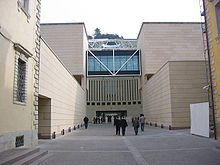
Carlo Carrà was an Italian painter and a leading figure of the Futurist movement that flourished in Italy during the beginning of the 20th century. In addition to his many paintings, he wrote a number of books concerning art. He taught for many years in the city of Milan.

Rovereto is a city and comune in Trentino in northern Italy, located in the Vallagarina valley of the Adige River.

Fortunato Depero was an Italian futurist painter, writer, sculptor, and graphic designer.
Museums of modern art listed alphabetically by country.
Tullio Crali was a Dalmatian Italian artist associated with Futurism. A self-taught painter, he was a late adherent to the movement, not joining until 1929. He is noted for realistic paintings that combine "speed, aerial mechanisation and the mechanics of aerial warfare", though in a long career he painted in other styles as well.

Ketty La Rocca was an Italian artist during the 1960s and 70s. She was a leading exponent of body art and visual poetry movements.
Paolo Canevari is an Italian contemporary artist. He lives and works in New York City. Canevari presents highly recognizable, commonplace symbols in order to comment on such concept as religion, the urban myths of happiness or the major principles behind creation and destruction.

Valerio Rocco Orlando is an Italian artist, Professor of Multimedia Dramaturgy at Brera Academy in Milan and PhD candidate in Engineering-based Architecture and Urban Planning at Sapienza University of Rome.
Barry X Ball is an American sculptor who lives and works in New York City.

The Archivio di Nuova Scrittura is a cultural association founded in 1988 in Milan, Italy by art collector Paolo Della Grazia. The archive preserves a large artistic and documentary heritage about any form of artistic expression featuring the use of both the word and the sign. Born from the encounter between Della Grazia and artist Ugo Carrega, in the 1990s the ANS became the main Italian research center on visual poetry, organizing exhibitions, meetings and other cultural events. In 1998 the Archivio di Nuova Scrittura was deposited in part at the Mart in Rovereto and in part at the Museion in Bozen. The artwork section of the ANS includes about 1,600 works by international artists at Mart and about 2,000 at Museion. The ANS archives preserve, apart from the internal archive of the association, the Fraccaro-Carrega fonds, containing the papers of collector Marco Fraccaro and visual poet Ugo Carrega. The library section, preserved at Mart, contains more than 18,000 volumes, among them 600 artist's books and hundreds of futurist first editions, and 600 art magazines including about 300 international artist's magazines.
Diether Kunerth was a German contemporary artist who lived in Ottobeuren, Upper Swabia.

Yumi Karasumaru is a Japanese artist. She lives and works in Bologna, Italy, and Kawanishi, Japan.
Paolo Ventura is an Italian photographer, artist and set designer based in Milan.
Grazia Toderi is an Italian artist working primarily in the medium of video art. Born in Padua, and trained in painting at the Academy of Fine Arts, Bologna, Toderi began working in the medium of media and video art in the 1990s. Currently working out of Milan and Turin, the MIT Museum describes her as "one of the most recognized visual artists working in Italy today". Toderi is inspired in part by Giotto and other early 14th-century painters, but "draws more heavily on contemporary experience, from distant views of cities glowing at night to the zero-gravity ballets of the U.S. space programs". Latvia's NOASS has described Toderi as first gaining critical attention in 1993 after participating in the 45th Venice Biennale, and "often referred to as one of the most important contemporary artists, working in fields of video projection and installation art and is recognized for her iconic use of aerial images of nighttime metropolitan cities." Much of Toderi's video art involves visualizations of the infinite, and Toderi credits this to a "formative moment in her childhood—watching the simulcast of the first moonwalk."
Gabriella Belli is an Italian art historian and curator, currently director of the Foundation for the municipal museums of Venice .

Pablo Echaurren is an Italian painter, comics artist and writer.
Lea Vergine, born Lea Buoncristiano, was an Italian art critic, essayist, and curator.
Carlo Belli was an Italian art critic, theorist, and writer.









